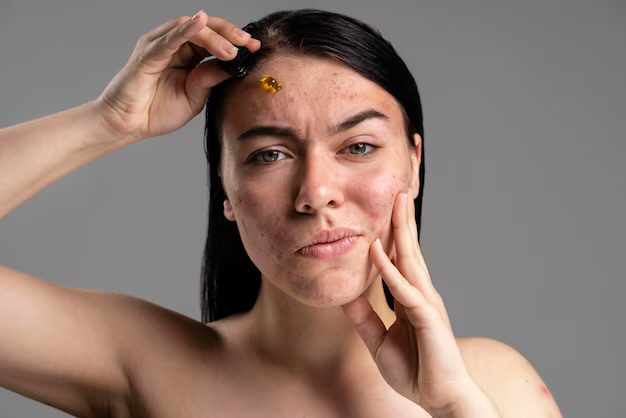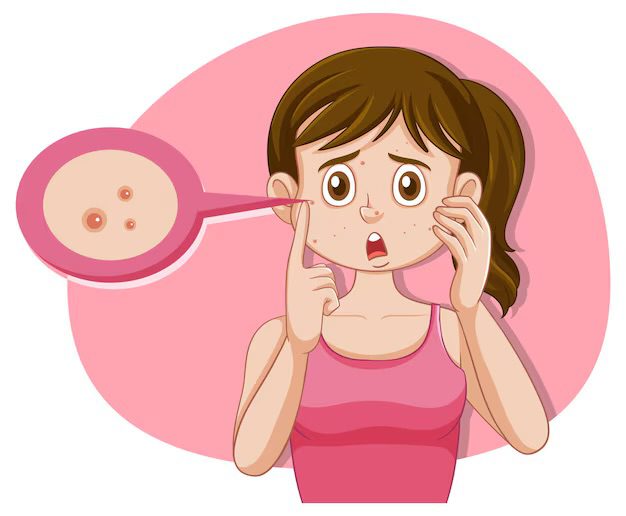This content is for informational and educational purposes only. Always consult a qualified healthcare provider.
Last Updated on September 20, 2024 by Grace Oluchi
Pre-menstrual breakouts, also known as pre-menstrual acne, are skin breakouts that occur in women just before their period starts and almost all women will experience them in their lifetime
Or it’s your period’s way of telling you “Yo I’m on my way, get ready”


The usual causes of these breakouts are hormonal fluctuations, specifically the increase in progesterone and androgens, which increase oil production in the skin. Which is why you get clogged pores, inflammation, and acne. They typically appear on the lower face, including the chin, jawline, and forehead, and can be mild to severe.
Pre-menstrual breakouts usually follow a predictable timeline, which starts 7-10 days before you start menstruating and peaking 3-5 days before. Genetics, diet, stress, and poor skincare routines can exacerbate breakouts. While, pre-menstrual breakouts are temporary, and usually resolve after your period is over, they can be frustrating and can affect one’s self-confidence. Or even worse, you could have your birthday party coming up, someone else’s party, or an event, and it shows up.
However, when you get informed about causes, and implement preventive measures, such as:
- Maintaining a skincare routine
- Eating a balanced diet
- Staying hydrated
- Managing your stress levels
You get to help reduce their occurrence and severity. By recognizing the signs and taking proactive steps, you can better manage pre-menstrual breakouts and achieve healthier, and clearer skin. Many ladies don’t know how to apply these things to their daily lives, but this article will help you do just that.
📋 Table of Contents
Symptoms of Pre-menstrual breakouts
- Painful or tender skin
- Blackheads or whiteheads
- Clogged pores
- Inflammation
- Itchy or irritated skin
- Cysts or nodules under the skin
- Swelling or puffiness of the skin
- Increased oiliness of the skin
- Formation of pimples or acne
- Changes in skin texture
Causes of Pre-menstrual breakouts
1 . Stress: It increases cortisol, which leads to inflammation of your skin.
2 . Water retention: When your body holds more water, it causes your pores to become more congested.
3 . Hormonal fluctuations: Changes in estrogen and progesterone levels can cause your skin to break out.
4 . Diet: Your diet may increase your chances of breaking out, such as dairy, sugar, and processed foods.
We’ll discuss the importance of eating certain foods to prevent pre-menstrual breakouts.
Types of breakouts
There are 3 types of pre-menstrual breakouts:
1 . Mild breakouts: They are small, occasional pimples or blackheads, and are usually confined to a specific area.
2 . Moderate breakouts: These are regular breakouts, some inflammation, and more widespread acne.
3 . Severe breakouts: They’re more intense and persistent acne and can appear as large, painful bumps or cysts.
Treatment options for Pre-menstrual breakouts
The good news is that you can attempt different niche treatments such as topical treatments, Oral medication, and natural remedies.
Let’s start with:
1 . Topical treatments
When it comes to treating pre-menstrual acne with topical treatments, you can consider using the following products:
- Tea tree oil (natural antibacterial agent)
- Salicylic acid (BHA) cleansers
- Niacinamide
- Benzoyl peroxide treatment
- Retinoids (can treat mild to moderate acne and can be used for long-term prevention.
2 . Oral medications
- Oral contraceptive pills (better known as birth control pills)
- Hormonal treatments (spironolactone)
- Oral antibiotics to reduce bacteria
3 . Natural remedies
- Aloe Vera gel ( product or straight from the plant)
- Aloe Vera gel and honey
- Green tea
- Honey
- Neem powder and rose water
- Cucumber
- Baking soda
- Probiotics
Other natural remedies people swear by
- Honey plus brown sugar
- Honey and coconut oil
- Lemon juice
- Rubbing tomatoes on the face
- Turmeric paste (combined with or yogurt)
- Apple cider vinegar (dilute with water and use a toner)
- Honey and cinnamon mask
- Honey plus lemon juice and yogurt
These remedies have generated results for many people, but you have to always run a patch test before using them. You might be desperate, but be patient and run a patch test, because what if it makes things worse? What works for others may not work for you, despite it being a general treatment. So, in order not to worsen things always run a patch test on the back of your hand, jawline/under your chin or around your nose.
How to prevent Pre-menstrual breakouts
1 . Avoid sugars. dairy, and processed foods, especially one week around that time.
2 . Don’t over-exfoliate, do it gently and 1-2 times a week.
3 . Stay hydrated by drinking plenty of water.
4 . Manage stress by practicing meditation, yoga, or going for evening walks.
5 . Use non-comedogenic products.
6 . Maintain a consistent skincare routine
7 . Eat a balanced diet (whole foods, fruits and vegetables)
8 . Don’t layer or mix too many different treatments (remember less is more).
9 . Use makeup sparingly.
10 . Reduce sun exposure.
11 . Use clean sheets, towels, and pillow covers.
You may not be able to avoid them completely, but you can reduce the intensity of the breakouts. But who knows, you just might be able to avoid them after all. If you diligently follow our instructions and practice Pre–menstrual care, you might avoid them altogether.
Certain lifestyle changes you can make
- Track your cycle
- Adjust your skincare routine accordingly
- Exercise regularly to improve circulation (running and jump rope can help your skin glow)
- Avoid picking or popping pimples
- Get enough sleep (7-8 hours)
- Enlighten yourself by reading Pre-menstrual care tips
The bottom line
Pre-menstrual breakouts are quite common, and most women if not all, experience them. They’re skin conditions that occur days before your period starts. Common causes of pre-menstrual acne are hormonal changes and a poor diet. Breakouts can vary from mild, to moderate to severe, but regardless of their levels, it’s important to take care of your skin. Eating well, avoiding sugary foods, dairy, and processed foods, drinking enough water, feeding your skin, sleeping well, and practicing good hygiene, can help prevent or manage pre-menstrual acne.
FAQs
When should I visit the dermatologist regarding Pre-menstrual breakouts?
Visit the dermatologist if your breakouts are severe or persistent, have cysts or nodules, or scarring, and are unresponsive to self-care.
How can you know it’s if pre-menstrual breakouts or just an every other day acne?
Pre-menstrual acne and everyday acne are quite different.
Pre-menstrual acne: Usually occurs 1 to 2 weeks before the period, and is typically on the chin, jawline, or lower face. Comes with cysts or inflamed pimples, and hormonal fluctuations ( mood swings, bloating).
While every other day acne has random timing, various locations on the face, blackheads, whiteheads, or mild pimples, and has no hormonal connection.
This is why it is imperative to track your breakouts and cycle to confirm the actual cause of your breakouts.
Are all pimples before my period pre-menstrual breakouts?
Not all pimples before your period are pre-menstrual acne because pre-menstrual acne typically occurs 1 to 2 weeks before your period, are hormone hormone-related, and appear on the chin, jawline, or lower face. And are inflammatory (red, painful, cystic)
However, other factors can cause pimples before your period starts such as:
- Stress
- Diet changes
- Skincare routine
- Hygiene
- Environmental factors

